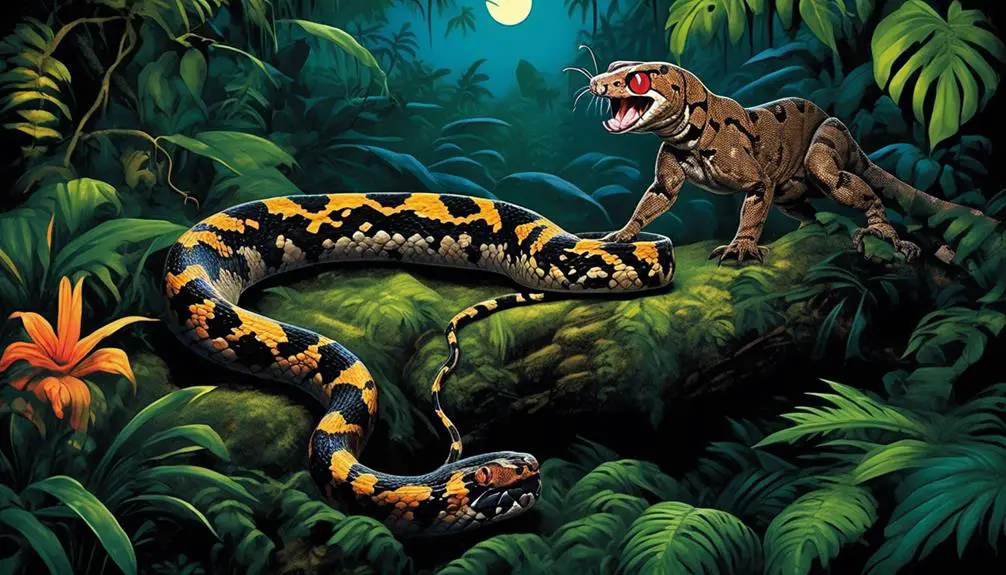So, you’re planning a trip to Guatemala, huh? Well, before you set off on your grand adventure, it’s important to familiarize yourself with the dangerous animals that roam this captivating country.
Guatemala is home to a diverse range of species that may pose a threat if encountered in the wrong circumstances. From the menacing Morelets crocodiles, with their aggressive nature and reputation for recorded attacks, to the venomous Red Rump Tarantulas with their vibrant hairs that can cause harm to humans, the wildlife here demands caution and respect.
But that’s not all – there are also Brown Bark Scorpions lurking in the shadows, armed with neurotoxic and cardiotoxic venom, as well as the highly venomous Barba Amarillas snakes that should be avoided at all costs.
And just wait until you hear about the majestic Jaguars, the largest big cat species in Central and South America, known for their powerful build and formidable hunting abilities. Oh, and did I mention the venomous Black Widow Spiders?
Trust me, you’ll want to stay tuned to find out more about these dangerous animals in Guatemala and how to keep yourself safe during your journey.
Morelets Crocodiles
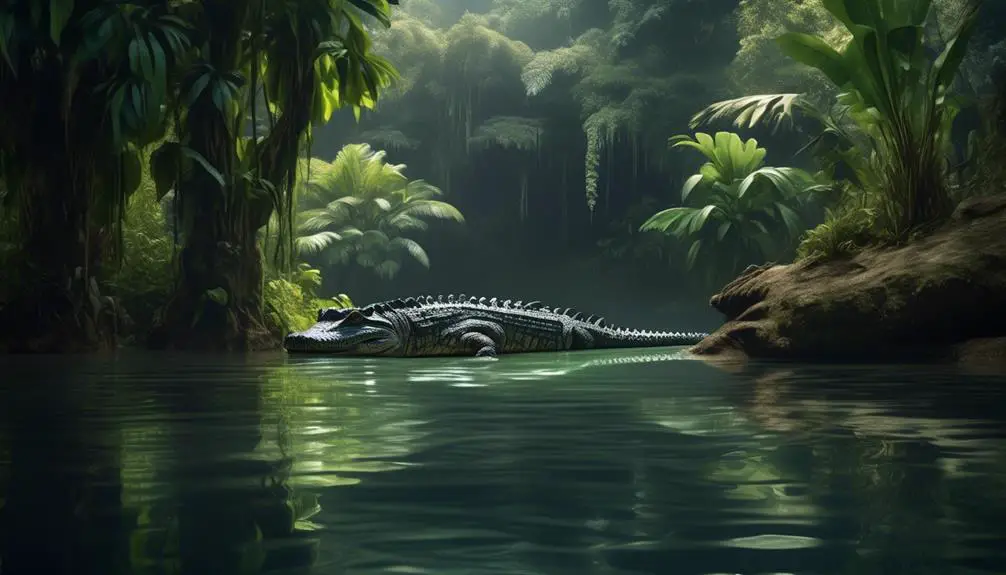
Morelets crocodiles, known for their aggressive nature and large populations in Guatemala, are a formidable presence in the country’s diverse ecosystems. These crocodiles, scientifically known as Crocodylus moreletii, can reach lengths of up to four meters, making them one of the largest crocodile species in the Americas. Their aggressive behavior has been well-documented, with 31 recorded attacks on humans since 2006.
One of the unique characteristics of Morelets crocodiles is their exclusive preference for mound nesting. Females construct large mounds of vegetation to protect their eggs from predators and ensure their successful hatching. This behavior showcases their dedication to ensuring the survival of their offspring.
It is important to note that Morelets crocodiles aren’t the only crocodile species found in Guatemala. American crocodiles (Crocodylus acutus) also inhabit the country and can be equally aggressive when provoked. These two species coexist in various ecosystems, adding to the richness of Guatemala’s biodiversity.
Encountering Morelets crocodiles in their natural habitat should be approached with caution and respect. It’s crucial to maintain a safe distance and avoid any actions that may provoke these powerful creatures. By adhering to these guidelines, we can continue to appreciate the beauty and significance of Morelets crocodiles in Guatemala’s ecosystems while ensuring our safety and the welfare of these magnificent reptiles.
Red Rump Tarantulas
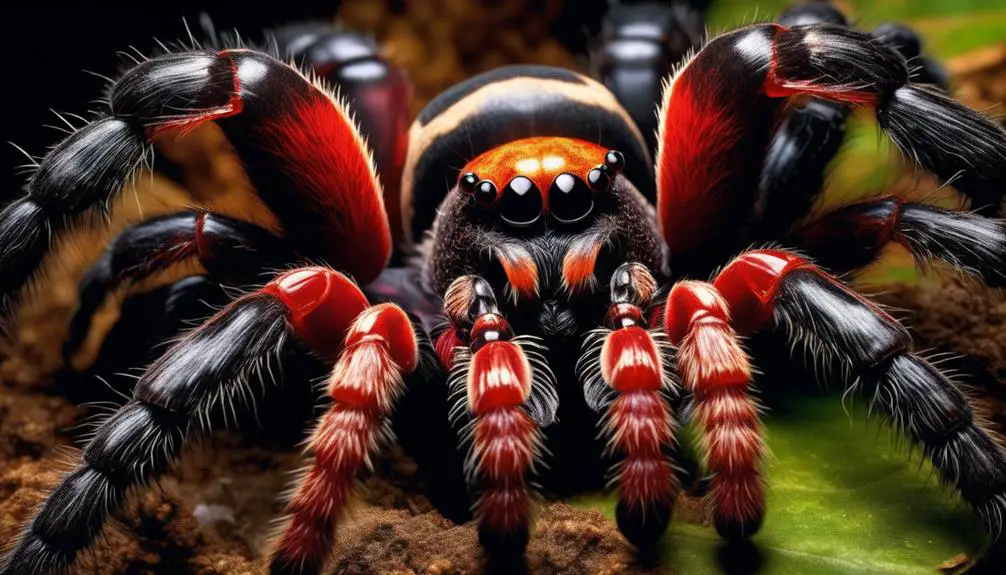
Red Rump Tarantulas, scientifically known as Tliltocatl vagans, are fascinating creatures found in Guatemala, showcasing their aggression and fast-moving nature. These arachnids are notable for their vibrant red hairs that develop on their abdomens in adulthood. Red Rump Tarantulas are known to be aggressive and quick in their movements, making them intriguing subjects for study.
These tarantulas utilize their vibrant hairs as a defense mechanism, stunning and discomforting their prey. While their bites aren’t typically fatal to humans, they can cause a nasty infection or even anaphylactic shock. Therefore, it’s crucial to exercise caution and avoid handling these creatures.
In their natural habitat, Red Rump Tarantulas play an important role in controlling insect populations. They’re skilled hunters and use their speed and aggression to catch their prey. Despite their intimidating appearance, these tarantulas are a vital part of the ecosystem in Guatemala.
If you come across a Red Rump Tarantula in the wild, it’s best to observe from a safe distance and avoid any sudden movements that may provoke them. Remember, these creatures are essential to the balance of nature in Guatemala, and it’s important to respect their space and allow them to carry out their natural behaviors undisturbed.
Brown Bark Scorpions
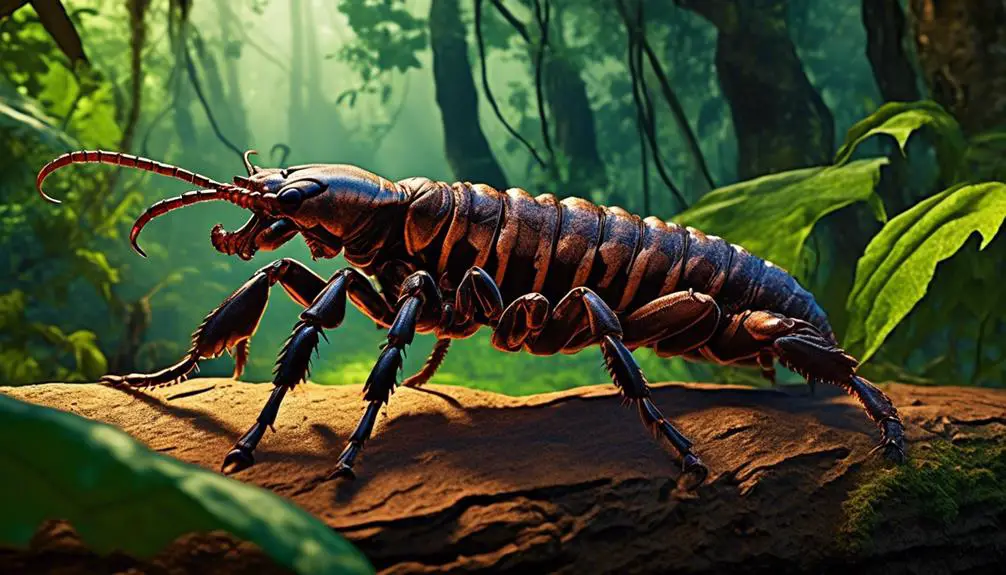
Brown Bark Scorpions, commonly found in the eastern forests of Guatemala, possess neurotoxic and cardiotoxic venom that can cause pain, swelling, and nausea. These venomous creatures are a formidable threat to humans and have garnered a reputation for their potent sting.
Brown Bark Scorpions can be found in various habitats, including human dwellings, where they seek shelter and feed on insects. Their venom, a deadly combination of neurotoxins and cardiotoxins, targets the nervous and cardiovascular systems, leading to severe symptoms.
The pain from a Brown Bark Scorpion sting is intense and can radiate throughout the body. Swelling at the site of the sting is common and may spread to nearby areas. Nausea and vomiting are also possible reactions to the venom.
These scorpions are a crucial part of the ecosystem, serving as prey for predators like the Red Rump Tarantula. It’s important to exercise caution and avoid contact with Brown Bark Scorpions to prevent the potential consequences of their venomous sting.
Cougars

With its diverse array of dangerous animals, Guatemala also serves as home to the majestic and formidable cougar. Cougars, also known as Pumas or Mountain Lions, are native to the Americas, including Guatemala. These powerful predators have a range that spans from the Canadian Yukon to the southern Andes. Cougars have slender bodies, round heads, and pointed ears, making them highly adaptable and efficient hunters. They are carnivores and primarily feed on deer, rodents, and birds. Cougars have the ability to climb trees, jump long distances, and possess incredible strength. Their stealth and agility make them formidable hunters, with no natural enemies to challenge their dominance.
To further understand the characteristics of cougars, refer to the table below:
| Characteristic | Description |
|---|---|
| Scientific Name | Puma concolor |
| Habitat | Varied, from forests to mountains to deserts |
| Average Length | Males: 7-8 feet; Females: 6-7 feet |
| Weight | Males: 115-220 pounds; Females: 75-150 pounds |
| Life Span | 8-13 years in the wild, up to 20 years in captivity |
| Conservation Status | Least Concern |
Encountering a cougar in the wild can be a thrilling experience, but it is essential to exercise caution. If you happen to come across a cougar, maintain a calm demeanor, and avoid sudden movements. Back away slowly while keeping eye contact with the animal. It is crucial not to turn your back or run, as this may trigger the cougar’s instinct to chase. Remember, cougars are a vital part of the ecosystem and deserve our respect and admiration from a safe distance.
Barba Amarillas
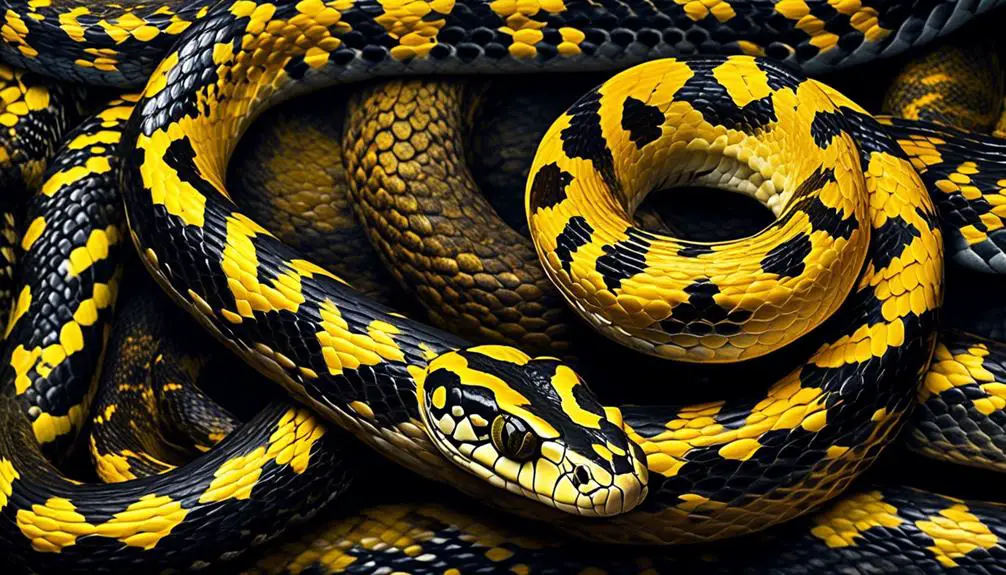
Barba Amarillas, also known as yellow-bearded pit vipers, are venomous snakes found in Guatemala. These snakes are highly dangerous and possess a potent bite.
With their yellow coloration on their throats, they’re easily recognizable, and encounters with them should be avoided at all costs to prevent potential bites.
Venomous Snake Behavior
Guatemala is home to a venomous snake species known as the Barba Amarillas, which exhibits fascinating and potentially dangerous behaviors. These snakes, scientifically known as Bothriechis schlegelii, are known for their striking yellow coloration on their throats, which is how they earned their name, meaning ‘yellow beard’ in Spanish.
Barba Amarillas are primarily found in forested areas and near water sources, where they hunt for their prey, which consists mainly of small mammals and birds. These snakes are highly venomous and possess a potent bite, delivering a neurotoxic venom that can cause severe pain, swelling, and even paralysis.
Additionally, Barba Amarillas are known for their arboreal behavior, spending a significant amount of time in trees, where they ambush their unsuspecting prey. It’s crucial to exercise caution and avoid encounters with these snakes to prevent potential bites and their potentially harmful consequences.
Prevention and Safety Measures
When encountering the venomous Barba Amarillas in Guatemala, it is crucial to take preventive measures and prioritize safety to mitigate the potential risks associated with their potent bites. These snakes are highly venomous and can deliver a powerful bite, making it essential to exercise caution in their presence. To ensure your safety, follow these preventive measures:
| Prevention Tips | Safety Measures |
|---|---|
| Wear protective clothing such as long pants and closed-toe shoes | Carry a snakebite kit and know how to use it |
| Stay on designated paths and avoid walking through tall grass or dense vegetation | Be vigilant and avoid handling or provoking the snake |
| Use a flashlight when walking at night to avoid accidentally stepping on the snake | Seek immediate medical attention if bitten, even if you don’t experience symptoms |
| Educate yourself on the appearance and behavior of Barba Amarillas to recognize and avoid them | Stay calm and try to remember the snake’s features for identification |
Jaguars

Jaguars, the largest big cat species in Central and South America, have a wide range of habitat preferences. With their powerful build and distinctive rosette patterns on their fur, they’re skilled hunters capable of taking down large prey.
As solitary animals, they play a crucial role in maintaining ecosystem balance as apex predators.
Habitat and Range
The vast and diverse landscapes of Central and South America provide an expansive habitat for the majestic and powerful predator that’s the jaguar.
These magnificent creatures can be found in a range of habitats, including tropical rainforests, swamps, grasslands, and even mountains. Jaguars have adapted to thrive in various environments, allowing them to establish territories across a wide geographic range.
They’re known to inhabit countries such as Guatemala, Mexico, Brazil, and Argentina. Within these regions, jaguars play a crucial role in maintaining ecosystem balance as apex predators.
Their habitat preferences and ability to adapt to different landscapes make them formidable hunters, capable of taking down large prey such as deer, capybaras, and even caimans.
The jaguar’s presence in these diverse habitats highlights its adaptability and resilience as a species.
Role in Ecosystem
Playing a crucial role in maintaining ecosystem balance, jaguars are powerful apex predators found in a wide range of habitats in Central and South America. These majestic cats are known for their distinctive rosette patterns on their fur and their skilled hunting abilities. Jaguars have a preference for dense forests, swamps, and grasslands, but they can adapt to various environments. As an apex predator, they play a vital role in regulating the populations of their prey, such as deer, peccaries, and capybaras.
By controlling herbivore populations, jaguars help maintain the balance of plant communities and prevent overgrazing. Additionally, their presence in ecosystems influences the behavior of other species, creating a cascading effect that benefits the overall health and biodiversity of the ecosystem.
| Role in Ecosystem |
|---|
| Control populations of herbivores |
| Maintain balance in plant communities |
| Influence behavior of other species |
| Contribute to overall health and biodiversity of the ecosystem |
Black Widow Spiders
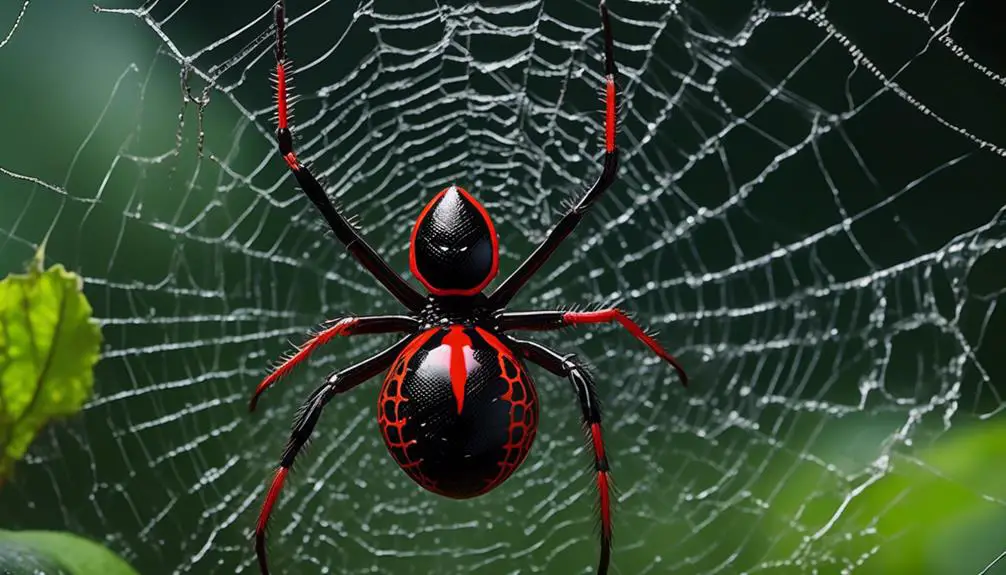
Black Widow Spiders, with their venomous bites and distinctive markings, pose a significant threat to humans in Guatemala. These spiders, scientifically known as Latrodectus mactans, are found throughout the country and are known for their shiny black bodies with a red hourglass-shaped mark on the abdomen. It’s important to note that female Black Widow Spiders are larger than males, reaching about 1.5 inches in length.
Encounters with Black Widow Spiders should be avoided at all costs, as their venom contains potent neurotoxins that can cause severe pain and muscle contractions. These venomous bites can result in a condition known as Latrodectism, which can lead to symptoms such as abdominal pain, sweating, difficulty breathing, and even paralysis.
Black Widow Spiders are primarily nocturnal hunters, using their webs to capture and immobilize their prey. They commonly inhabit dark and sheltered areas, such as woodpiles, garages, and sheds. It’s crucial to exercise caution when reaching into these spaces or when handling objects that have been left undisturbed for a long time.
If you’re bitten by a Black Widow Spider, it’s essential to seek immediate medical attention. Antivenom is available and can be administered by healthcare professionals to counteract the effects of the venom. Remember, prevention is key, so take precautions to avoid encounters with these dangerous spiders and ensure your safety in Guatemala.
Fer-de-Lance Snakes

With the dangers of Black Widow Spiders fresh in your mind, let’s now turn our attention to the formidable Fer-de-Lance Snakes found in Guatemala. These snakes, scientifically known as Bothrops asper, are widely considered one of the most dangerous snakes in Central America. They possess a potent venom that can cause severe tissue damage and even death if left untreated.
The Fer-de-Lance is characterized by its robust body, triangular-shaped head, and distinctive markings, including a dark brown coloration with a series of dark, diamond-shaped patterns. These snakes are primarily found in forested areas and can also be encountered near rivers and agricultural fields.
Fer-de-Lance Snakes are ambush predators, relying on their excellent camouflage to blend in with their surroundings and strike unsuspecting prey. Their diet consists mainly of small mammals, birds, and reptiles. Despite their preference for a specific diet, these snakes won’t hesitate to defend themselves if they feel threatened. Their venom contains a potent cocktail of toxins that can cause severe pain, swelling, and tissue necrosis. Prompt medical attention is vital in case of a bite.
Encounters with Fer-de-Lance Snakes should be avoided at all costs. When venturing into their habitats, it’s crucial to wear appropriate protective clothing, such as sturdy boots and long pants. Additionally, being cautious and observant of your surroundings can help minimize the risk of encountering these dangerous creatures. Remember, the Fer-de-Lance Snake is a formidable predator and must be respected for the potential harm it can cause.
Fer-de-Lance Snakes
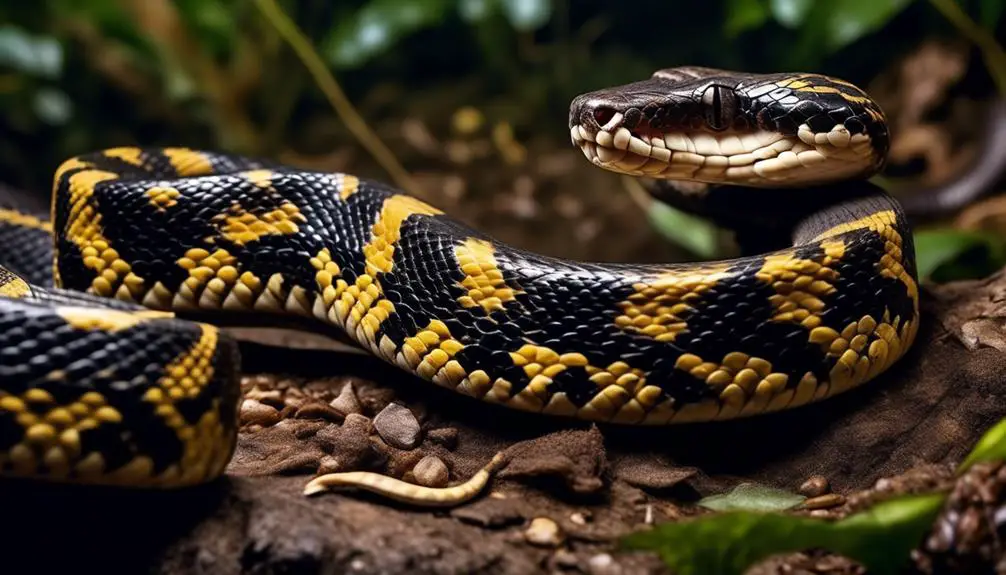
Fer-de-Lance snakes, scientifically known as Bothrops asper, are venomous snakes found in Guatemala. They possess distinct characteristics such as triangular-shaped heads, heat-sensing pits, and a tan or brown coloration.
These snakes prefer a variety of habitats including forests, grasslands, and rocky areas.
Their bites can be extremely dangerous, causing symptoms such as severe pain, swelling, and tissue damage, making encounters with Fer-de-Lance snakes a serious concern in Guatemala.
Venomous Snake Characteristics
What are the distinguishing characteristics of venomous snakes, specifically the Fer-de-Lance species, found in Guatemala? Fer-de-Lance snakes, scientifically known as Bothrops asper, are highly venomous and pose a significant threat to humans. Here are some key characteristics of these dangerous snakes:
| Characteristic | Description |
|---|---|
| Size | Fer-de-Lance snakes can grow up to 2 meters in length, making them one of the largest venomous snakes in the region. |
| Coloration | They have a distinctive color pattern, with a dark brown or olive-brown body and a lighter-colored belly. This helps them blend in with their surroundings, making them difficult to spot. |
| Head Shape | Their head is triangular and broad, with prominent heat-sensing pits located between their eyes and nostrils. These pits allow them to detect warm-blooded prey, even in darkness or dense vegetation. |
| Venomous Bite | Fer-de-Lance snakes possess long, hinged fangs that deliver a potent hemotoxic venom. Their bite can cause severe tissue damage, swelling, pain, and potentially life-threatening complications if left untreated. |
Encountering Fer-de-Lance snakes should be avoided at all costs to minimize the risk of potentially dangerous bites. Their venomous nature and aggressive behavior make them a significant threat in Guatemala’s ecosystem. Stay informed and take necessary precautions when venturing into their habitat.
Fer-De-Lance Habitat Preferences
The Fer-de-Lance snake, also known as Bothrops asper, possesses specific habitat preferences that contribute to its survival and thriving presence in Guatemala’s ecosystem. These venomous snakes are commonly found in various habitats such as lowland rainforests, cloud forests, and agricultural areas. They have a preference for dense vegetation and can often be found near rivers, streams, and other water sources. This allows them to have access to both prey and suitable hiding places.
The Fer-de-Lance also favors areas with a high abundance of small mammals, birds, and amphibians, as these serve as their main sources of food. It’s important to note that their habitat preferences can overlap with human settlements, making encounters with these dangerous snakes more likely. Therefore, it’s crucial to exercise caution and avoid areas where Fer-de-Lance snakes are known to inhabit.
Fer-De-Lance Bite Symptoms
Beware the venomous bite of the Fer-de-Lance snake, as its symptoms can be severe and potentially life-threatening. When bitten by this highly venomous snake, you may experience immediate pain and swelling at the site of the bite.
The venom of the Fer-de-Lance contains powerful enzymes that can cause tissue damage, leading to necrosis and the formation of deep ulcers. Systemic symptoms may include nausea, vomiting, dizziness, and difficulty breathing. In severe cases, the venom can disrupt blood clotting, leading to uncontrollable bleeding.
Immediate medical attention is crucial if bitten by a Fer-de-Lance snake, as antivenom is necessary to counteract the effects of the venom. Remember to avoid handling or provoking these snakes to reduce the risk of a dangerous encounter.
Fer-de-Lance Snakes
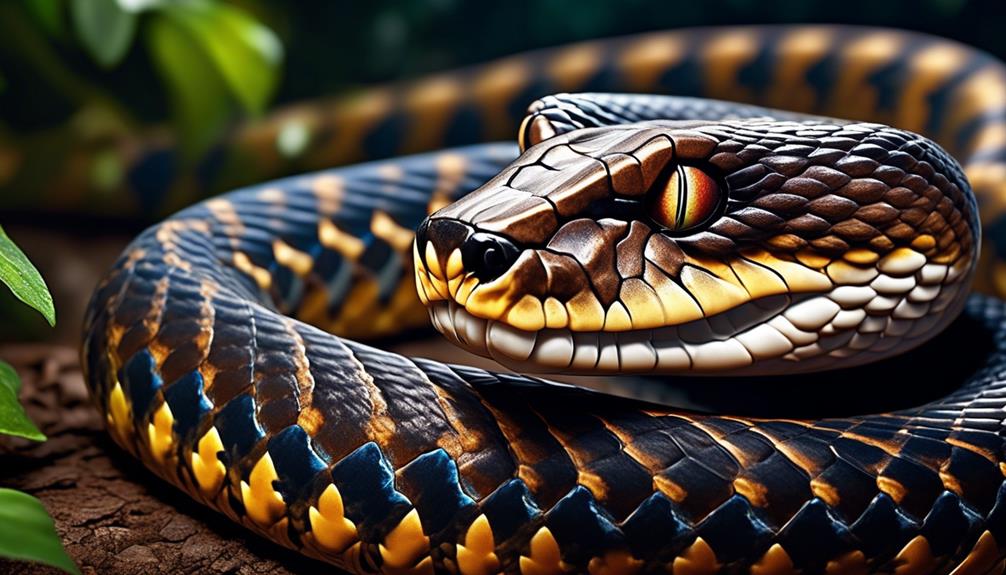
Fer-de-Lance snakes, known scientifically as Bothrops asper, are highly venomous reptiles that inhabit the forests of Guatemala. These formidable creatures are a force to be reckoned with, as their venomous bite can cause severe pain, tissue damage, and even death if not treated promptly. The Fer-de-Lance snake is known for its aggressive nature, making it a significant threat to humans and other animals that cross its path.
One of the distinguishing features of the Fer-de-Lance snake is its triangular-shaped head, which is indicative of its venomous capabilities. This venom is a potent cocktail of enzymes and toxins that can lead to rapid tissue destruction and coagulation disorders. If bitten by a Fer-de-Lance snake, immediate medical attention is crucial to prevent the venom from spreading and causing further harm.
The Fer-de-Lance snake is a master of camouflage, blending seamlessly into its surroundings with its brown or tan-colored scales. This makes it even more dangerous, as it can easily go unnoticed until it strikes. It’s important to exercise caution when venturing into the forests of Guatemala and to be aware of your surroundings at all times.
Fer-de-Lance Snakes
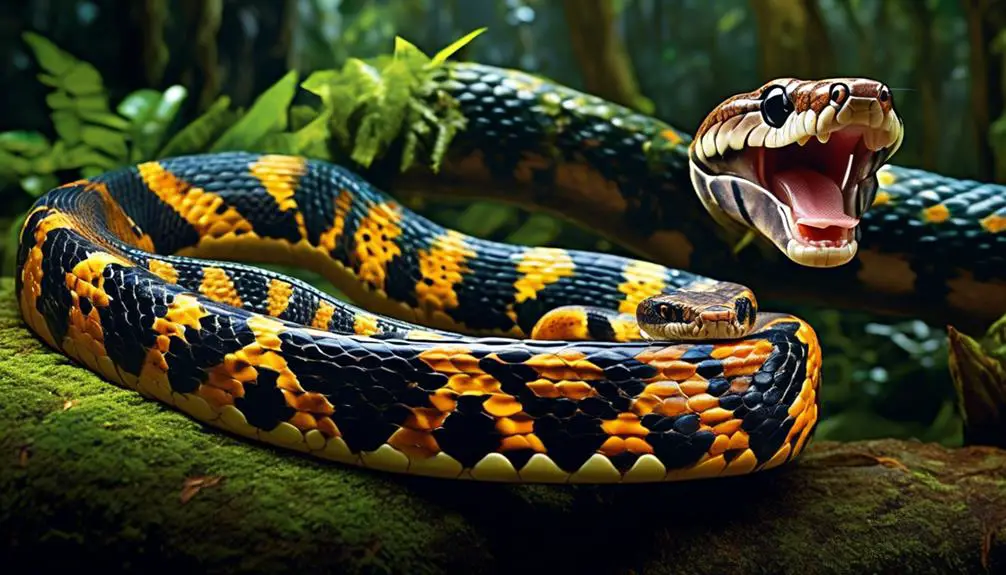
Found in the forests of Guatemala, the Fer-de-Lance snake is a highly venomous reptile with a triangular-shaped head and a reputation for its aggressive nature. This species, scientifically known as Bothrops asper, is a member of the pit viper family and is widely feared for its potent venom. The Fer-de-Lance snake can grow up to 2 meters in length and possesses a heat-sensing pit located between its eyes and nostrils, which enables it to detect warm-blooded prey. Its venom contains a cocktail of toxins that can cause severe tissue damage, bleeding, and even death if left untreated.
Encounters with the Fer-de-Lance snake should be avoided at all costs. These snakes are ambush hunters and typically strike with lightning speed, delivering their venomous bite before their prey has a chance to react. Their aggressive nature, coupled with their ability to camouflage themselves in their natural habitat, makes them a formidable threat. In fact, the Fer-de-Lance snake is responsible for the majority of snakebite incidents in Guatemala.
If you find yourself in an area where Fer-de-Lance snakes are known to inhabit, it’s crucial to exercise caution and be aware of your surroundings. Wear protective clothing, such as long pants and boots, to minimize the risk of a bite. Be cautious when stepping over fallen logs or rocks, as these snakes often hide in such areas. In the unfortunate event of a bite, seek medical attention immediately. Time is of the essence, as the venom can rapidly cause severe complications. Remember, prevention and awareness are key when it comes to staying safe from the dangerous Fer-de-Lance snake.

Erzsebet Frey (Eli Frey) is an ecologist and online entrepreneur with a Master of Science in Ecology from the University of Belgrade. Originally from Serbia, she has lived in Sri Lanka since 2017. Eli has worked internationally in countries like Oman, Brazil, Germany, and Sri Lanka. In 2018, she expanded into SEO and blogging, completing courses from UC Davis and Edinburgh. Eli has founded multiple websites focused on biology, ecology, environmental science, sustainable and simple living, and outdoor activities. She enjoys creating nature and simple living videos on YouTube and participates in speleology, diving, and hiking.

